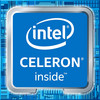Intel Celeron J4105 vs Google Tensor G4 vs ARM Cortex-M4
Intel Celeron J4105
► remove from comparison
Der Intel Celeron J4105 ist ein Ende 2017 vorgestellter Quad-Core-SoC für Desktops, der hauptsächlich in preiswerten Mini-PCs verbaut wird. Er taktet mit 1,5 bis 2,5 GHz (Einzelkern Burst) und gehört der Gemini-Lake-Plattform an. Die Fertigung erfolgt wie beim Vorgänger Apollo Lake in einem 14-Nanometer-Prozesses mit FinFETs. Neben den vier CPU-Kernen integriert der Chip auch eine DirectX-12-fähige Grafikeinheit sowie einen DDR4/LPDDR4-Speichercontroller (Dual-Channel, 2.400 MHz). Der SoC kann nicht ausgetauscht werden, da er direkt mit dem Mainboard verlötet wird (BGA Package).
Architektur
Die Prozessor-Architektur der Gemini Lake SoCs wurde im Vergleich zum Vorgänger leicht weiterentwickelt. Intel nennt sie nun Goldmont Plus Kerne und verdoppelt den Level 2 Cache von 2 auf 4 MB. Trotzdem sollte die Pro-MHz-Leistung noch deutlich hinter den aktuellen Kaby-Lake Prozessoren bleiben.
Google Tensor G4
► remove from comparisonThe Google Tensor G4 is the processor powering Pixel 9 series phones that debuted in August 2024. It certainly is well-connected, with both 5G and Wi-Fi 7 onboard. According to reports, the chip is built using one of Samsung's 4 nm processes making for decent power efficiency, as of late 2024.
The CPU part of the SoC is made up of 8 cores. The Cortex-X4 reportedly runs at 3.1 GHz and is the fastest of the bunch. Then there are also 3 Cortex-A720 cores (2.6 GHz) and 4 very frugal Cortex-A520 cores (1.95 GHz). This setup is only just enough for middling benchmark scores that are a far cry from what the Snapdragon 8 Gen 3, not to mention the A18 Pro deliver.
The G715 MP7 reportedly serves as the graphics adapter.
ARM Cortex-M4
► remove from comparison| Model | Intel Celeron J4105 | Google Tensor G4 | ARM Cortex-M4 | ||||||||||||||||||||||||||||||||||||||||||||||||||||||||||||||||||||||||||||||||||||||||||||||||||||||||||||||||||||||||||||||||||||||||||||||||||||||||||||||||||||||||||||||||
| Series | Intel Gemini Lake | ||||||||||||||||||||||||||||||||||||||||||||||||||||||||||||||||||||||||||||||||||||||||||||||||||||||||||||||||||||||||||||||||||||||||||||||||||||||||||||||||||||||||||||||||||
| Codename | Gemini Lake | ||||||||||||||||||||||||||||||||||||||||||||||||||||||||||||||||||||||||||||||||||||||||||||||||||||||||||||||||||||||||||||||||||||||||||||||||||||||||||||||||||||||||||||||||||
| Serie: |
|
|
| ||||||||||||||||||||||||||||||||||||||||||||||||||||||||||||||||||||||||||||||||||||||||||||||||||||||||||||||||||||||||||||||||||||||||||||||||||||||||||||||||||||||||||||||||
| Clock | 1500 - 2500 MHz | 1950 MHz | |||||||||||||||||||||||||||||||||||||||||||||||||||||||||||||||||||||||||||||||||||||||||||||||||||||||||||||||||||||||||||||||||||||||||||||||||||||||||||||||||||||||||||||||||
| L2 Cache | 4 MB | ||||||||||||||||||||||||||||||||||||||||||||||||||||||||||||||||||||||||||||||||||||||||||||||||||||||||||||||||||||||||||||||||||||||||||||||||||||||||||||||||||||||||||||||||||
| Cores / Threads | 4 / 4 | 8 / 8 1 x ARM Cortex-X4 3 x ARM Cortex-A720 4 x ARM Cortex-A520 | |||||||||||||||||||||||||||||||||||||||||||||||||||||||||||||||||||||||||||||||||||||||||||||||||||||||||||||||||||||||||||||||||||||||||||||||||||||||||||||||||||||||||||||||||
| TDP | 10 Watt | ||||||||||||||||||||||||||||||||||||||||||||||||||||||||||||||||||||||||||||||||||||||||||||||||||||||||||||||||||||||||||||||||||||||||||||||||||||||||||||||||||||||||||||||||||
| Technology | 14 nm | 4 nm | |||||||||||||||||||||||||||||||||||||||||||||||||||||||||||||||||||||||||||||||||||||||||||||||||||||||||||||||||||||||||||||||||||||||||||||||||||||||||||||||||||||||||||||||||
| max. Temp. | 105 °C | ||||||||||||||||||||||||||||||||||||||||||||||||||||||||||||||||||||||||||||||||||||||||||||||||||||||||||||||||||||||||||||||||||||||||||||||||||||||||||||||||||||||||||||||||||
| Socket | BGA1090 | ||||||||||||||||||||||||||||||||||||||||||||||||||||||||||||||||||||||||||||||||||||||||||||||||||||||||||||||||||||||||||||||||||||||||||||||||||||||||||||||||||||||||||||||||||
| Features | DDR4-2400/LPDDR4-2400 RAM, PCIe 2, MMX, SSE, SSE2, SSE3, SSSE3, SSE4.1, SSE4.2, VMX, SMEP, SMAP, MPX, EIST, TM1, TM2, Turbo, AES-NI, RDRAND, RDSEED, SHA, SGX | ||||||||||||||||||||||||||||||||||||||||||||||||||||||||||||||||||||||||||||||||||||||||||||||||||||||||||||||||||||||||||||||||||||||||||||||||||||||||||||||||||||||||||||||||||
| iGPU | Intel UHD Graphics 600 (250 - 750 MHz) | ARM Mali-G715 MP7 | |||||||||||||||||||||||||||||||||||||||||||||||||||||||||||||||||||||||||||||||||||||||||||||||||||||||||||||||||||||||||||||||||||||||||||||||||||||||||||||||||||||||||||||||||
| Architecture | x86 | ARM | |||||||||||||||||||||||||||||||||||||||||||||||||||||||||||||||||||||||||||||||||||||||||||||||||||||||||||||||||||||||||||||||||||||||||||||||||||||||||||||||||||||||||||||||||
| $107 U.S. | |||||||||||||||||||||||||||||||||||||||||||||||||||||||||||||||||||||||||||||||||||||||||||||||||||||||||||||||||||||||||||||||||||||||||||||||||||||||||||||||||||||||||||||||||||
| Announced | |||||||||||||||||||||||||||||||||||||||||||||||||||||||||||||||||||||||||||||||||||||||||||||||||||||||||||||||||||||||||||||||||||||||||||||||||||||||||||||||||||||||||||||||||||
| Manufacturer | ark.intel.com |


 Deutsch
Deutsch English
English Español
Español Français
Français Italiano
Italiano Nederlands
Nederlands Polski
Polski Português
Português Русский
Русский Türkçe
Türkçe Svenska
Svenska Chinese
Chinese Magyar
Magyar
